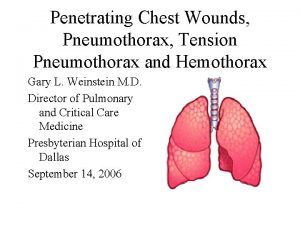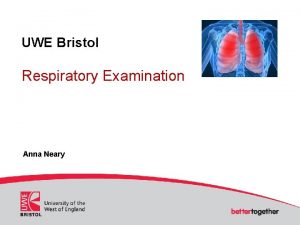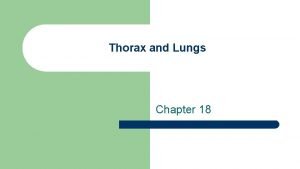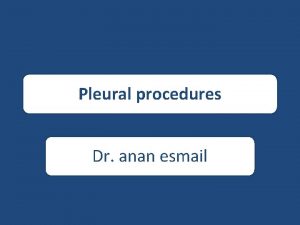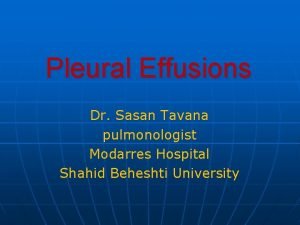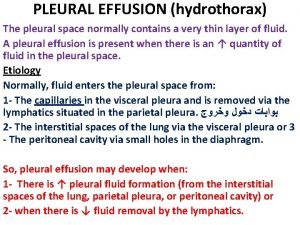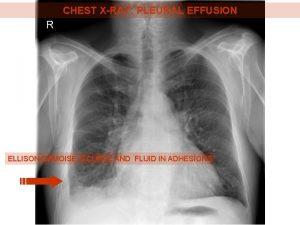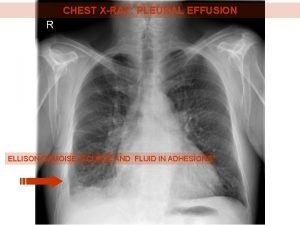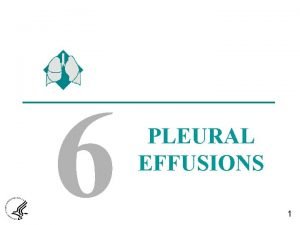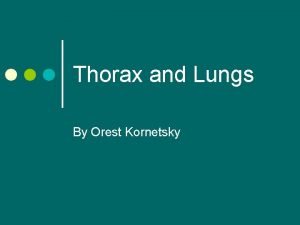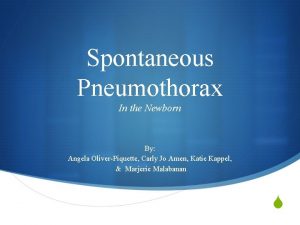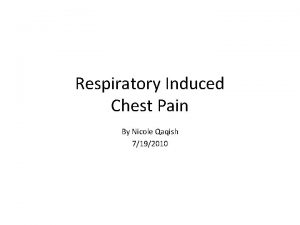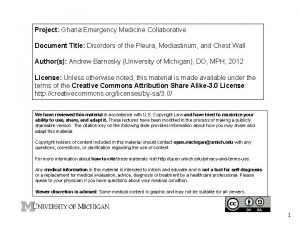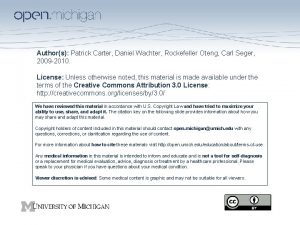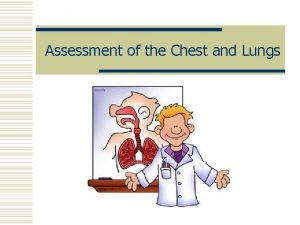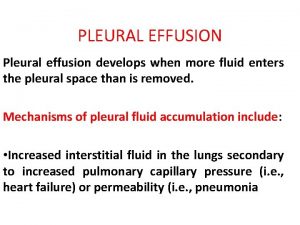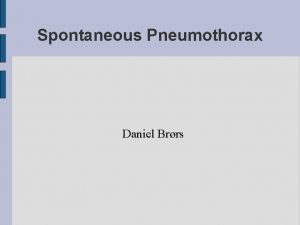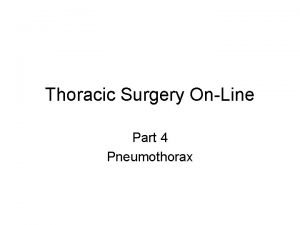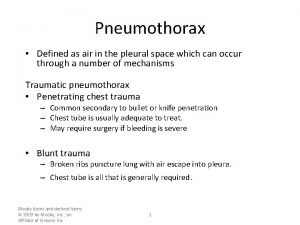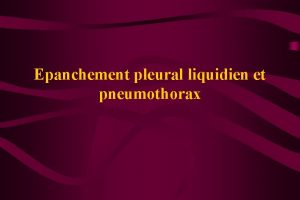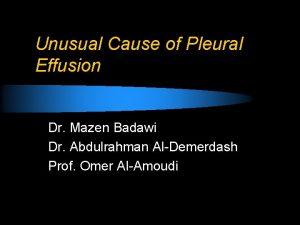Pleural effusion pneumothorax presentation for english medical students





























- Slides: 29

Pleural effusion, pneumothorax (presentation for english medical students) Dr. Farkas Attila, Dr. Agócs László, Dr. Kocsis Ákos, Dr. Mészáros László, Dr. Török Klára, Dr. Gieszer Balázs, Dr. Radeczky Péter, Dr. Rényi-Vámos Ferenc , Prof. Dr. Lang György National Institute of Oncology Thoracic Surgery Department, Semmelweis University Thoracic Surgery Clinic

I. case • What are the origins of pleural fluids? • (transudate-exudate)? 1. cardial- transudate 2. inflammation (pneumonia/pleuritis)- exudate 3. cancers (primary/secondary)- exudate (rarely transudate) 4. pulmonary embolism- exudate (rarely transudate) 5. liver cirhossis with ascites- transudate 6. nephrotic syndrome- transudate +(haemothorax, chylothorax, empyema)

I. case How can we get information about the fluid? thoracocentesis /chest drainage What do we examine? machroscopically protein, LDH (transudate-exudate differential diagnosis) - cytology - bacterial, fungal culture • • -

I. case Chest tube drainage • • 4. intercostal space in the midaxillary line 2. intercostal space in the medioclavicular line Test punction! Always above the ribs!

I. case Treatment 1, In case of T 1 -3, epithelial and hemithorax localized form (no abdominal appearance or distant metastasis): Operation A, Pleurectomy and decortication ( resection of the visceral and parietal pleura) B, Extrapleural pleuropulmonectomy (resection of the visceral and parietal pleura + lung + diaphragma + pericardium) - After the operation: chemo-radiotherapy 2, Non operable diseases: - Chemo-radiotherapy

Pneumothorax symptoms • most common is spontaneous pneumothorax • typical symptoms: - stabbing chest pain - heavy cough - dyspnoea. • in case of tension pneumothorax, and older patients always associated with cardiac complaints - tachycardia, extrasystoles, acute heart failure, cyanosis

Types of PTX 1. Based on pressure conditions 2. Based on extension 3. Based on etiological

1. Based on pressure conditions vsimple PTX - Open pneumothorax - Closed pneumothorax vventil PTX

2. Based on extension vcomplete vpartial vtire PTX vbilateral pneumothorax

3. Based on etiological vprimary (spontaneous) PTX vsecondary - preliminary pulmonary disease - traumatic: open or closed - iatrogenic pneumothorax

Treatment • Observation: tire pneumothorax, or pneumothorax case of smallscale • Aspiration: pneumothorax may be solved, the action can be repeated. In case of complete or tension pneumothorax is applicable only in medical first aid. • Drainage (thoracentesis): This is the main therapeutic procedure in the treatment of pneumothorax. In 80 -90% of cases lead to a cure • Surgery: 10 -20% of the patients so they can achieve the healing process, which may thoracotomy / VATS. Surgery is indicated for: (1) if neither expands the lungs during treatment intake for 48 -72 hours; (2) if the drain was inserted through the 24 hours is too longterm flow is observed; (3) if hemopneumothorax was observed and the rate of major bleeding or is not reduced; (4) other vital organ injury, or a reasonable suspicion; (5) recurrent pneumothorax

Empyaema thoracis

Staging 1. exudative stage: 24 -72 hours – inflamation of pleura and enhanced permeability of blood vessels, clear pleural effusion develops a low white blood cell count 2. fibrinopurulent stage: 7 -10 days - fibrin in the pleural space -> septa, the denser the liquid, turbid, white blood cell count increases Indicating the presence of anaerobic bacterial metabolism of the exudate shows a decrease in p. H and glucose combined with high LDH activity organised stage: 2 -4 weeks - fibroblasts infiltrate in the pleural space, the thin intrapleural membranes thicken, become inelastic. This rigid fibrous sheath inhibits lung to expand reduce the respiratory function and difficult to cure infections. 3.

Etiology 1. Parapneumonic effusion 2. Haematogenous spread into pleural space 3. Iatrogenic infection of the pleural space (thoracocentesis) 4. Postoperative (pulmonary, cardiac, abdominal, urological) 5. Descending oropharyngeal infection 6. Mediastinal infection ( oesophageal perforation) 7. Chest wall and spine infection 8. Traumatic penetrating injury

Bacteriology • most common Streptococcus milleri, Sterptococcus pneumoniae, Staphylococcus aureus • most common in nosocomial infection: Klebsiella, Proteus, Staphylococcus aureus, Pseudomonas aeruginosa, MRSA • fungal empyema is most common in immunosuppressive conditions

Symptoms • acute state: septic-toxic symptoms • chronic state: improving the general condition; often been without a fever; laboratory abnormalities get better; cardiopulmonary capacity reduced; chest pain; cough; dyspnoe

Therapy • 1 st stage: - pleural drainage - targeted antibiotic therapy - additional treatment (diet, vitamins, roboration, symptomatic therapy) • 2 nd stage: - drainage and lavage - early decortication, lavage, debridement (VATS / thoracotomy) - fibrinolysis (streptokinase), • 3 rd stage: - decortication (VATS / thoracotomy) - if the decorticatio not feasible, residual empyema cavity remains fenestration ("open window" chest training window)

Haemothorax

Etiology • most often injuries of the chest of the bleeding in the chest wall and blood vessels, lungs, heart and major blood vessels or damage to the diaphragm. • iatrogenic hemothorax: most common reasons for central venous cannulation, drainage, pleurabiopsy, transthoracic pulmonarybiopsy, • spontaneous hemothorax: rare disease

Symptoms • vascular symptoms caused by blood pooling exacerbated respiratory deterioration due to compression atelectasis • young, otherwise healthy patients - eg. In case of accident caused by acute hemothorax - a relatively greater blood loss symptoms can be surprisingly poor for a while

Diagnosis • anamnesis • physical examination • often in connection with pneumothorax accident mechanism, subcutaneous emphysema can be detected • X-ray examination shows the effusion, possible pneumothorax, mediastinal throughput rate, rib fractures, etc. • puncture

Therapy • bed rest, routing: less than 500 ml in case of hemothorax; lowergrade fever may accompany absorption; Duration: 1 -2 weeks • puncture: partly diagnostic and partly for therapeutic purposes; First get the medical care have a role (diagnosis, relief) • drainage: if more than 1000 ml hemothorax; Advantages: (1) improved evacuation, (2) constant control bleeding, (3) faster than expected, fewer complications • VATS exploration: a causative diagnosis and the severity of the bleeding to clarify • thoracotomy is indicated when (1) vascular, lung, heart, diaphragm injury there is a reasonable suspicion; (2) from the drain strong non damped bleeding (more than 100 ml / h).

Chylothorax

Etiology 1. congenital chylothorax 2. spontaneous chylothorax: no demonstrable cause in the background 3. secondary chylothorax - accident: thoracic duct or inferiority branch injury - malignant lung or mediastinal tumor: a rare - postoperative - after central venous catheter insertion left subclavian vein thrombosis

Symptoms • general symptoms of thoracic effusions (pleural, cardiac, respiratory) • after a long period of time corresponding significant fat and protein as lost serious consequences

Diagnostic anamnesis physical examination lab test X-ray puncture test: chylus viscous, cream color and consistency, fats, triglycerides, high in protein, high specific gravity (> 1016), usually sterile, odourless liquid with a p. H greater than 7. 5. • (A pseudochylus pathogen protein and usually rich in fat, viscous, white fluid in the chest. ) • • •

Therapy • pleural drainage • low-fat diet and protein, electrolytes and fluids replacement • sometimes the sustained sucking chest also comes into play, although it is rarely a permanent solution • in case of postoperative chylothorax drainage should be considered in addition to the long-term possibility of surgery as well (the thoracic duct and ligation visit to the site of injury)

Prognosis • definitely wrong • developed cancer as a result of chylothorax worsen due to the underlying disease already bad prognosis • „spontaneous" chylothorax mortality is around 50%, with significant amounts of fat, protein, fluid and electrolyte loss • intravenous nutrition favorably affect the prognosis • after successful surgery, the patient can heal, although recurrences are common

 Difference between simple and tension pneumothorax
Difference between simple and tension pneumothorax Meniscus sign pleural effusion
Meniscus sign pleural effusion Tactile fremitus vs vocal fremitus
Tactile fremitus vs vocal fremitus Increased tactile fremitus occurs with
Increased tactile fremitus occurs with Percuss anterior chest
Percuss anterior chest Pleural effusion color chart
Pleural effusion color chart Pleurodesis
Pleurodesis Dr sasan beheshti
Dr sasan beheshti Complications of empyema
Complications of empyema Hydrothorax and pleural effusion difference
Hydrothorax and pleural effusion difference Ellis curve in pleural effusion
Ellis curve in pleural effusion Garland triangle pleural effusion
Garland triangle pleural effusion Pleural effusion concept map
Pleural effusion concept map Ellis curve x ray
Ellis curve x ray Pleural effusion ellis curve
Pleural effusion ellis curve Tactile fremitus pleural effusion
Tactile fremitus pleural effusion Pleural effusion abg results
Pleural effusion abg results Cervical pleura
Cervical pleura Transudate
Transudate Hemothorax
Hemothorax Tactile vocal fremitus
Tactile vocal fremitus Pneumothorax in newborn
Pneumothorax in newborn Conncets
Conncets Primary vs secondary spontaneous pneumothorax
Primary vs secondary spontaneous pneumothorax Flail chest symptoms
Flail chest symptoms Pneumothorax in newborn
Pneumothorax in newborn Massive hemothorax
Massive hemothorax Wikipedia
Wikipedia Askep stroke sdki
Askep stroke sdki Pneumonia and tactile fremitus
Pneumonia and tactile fremitus
